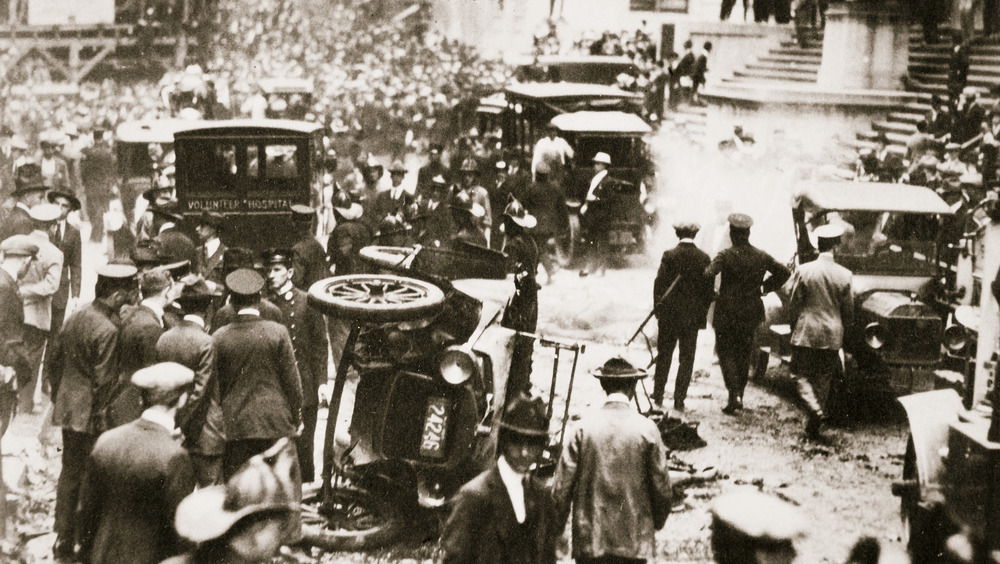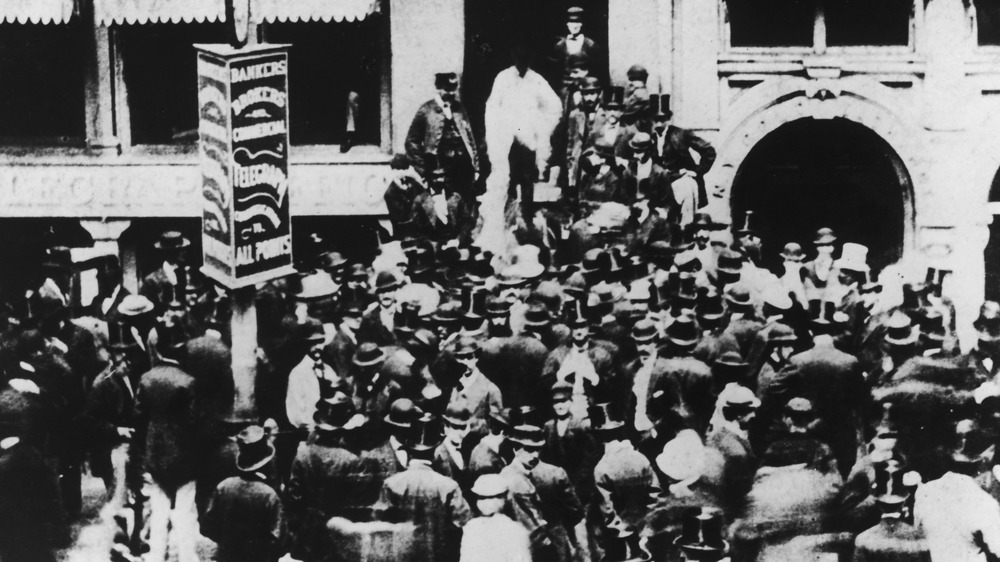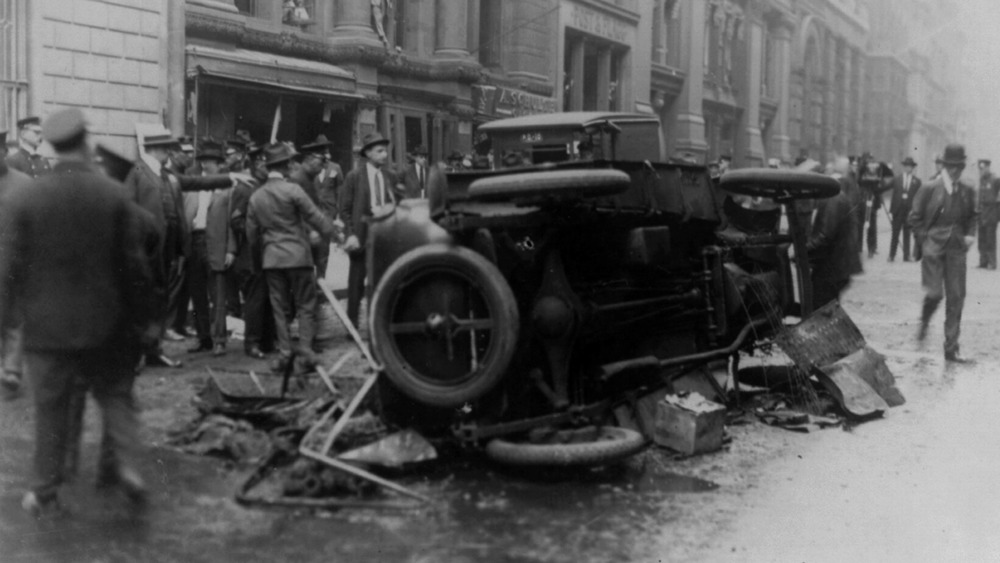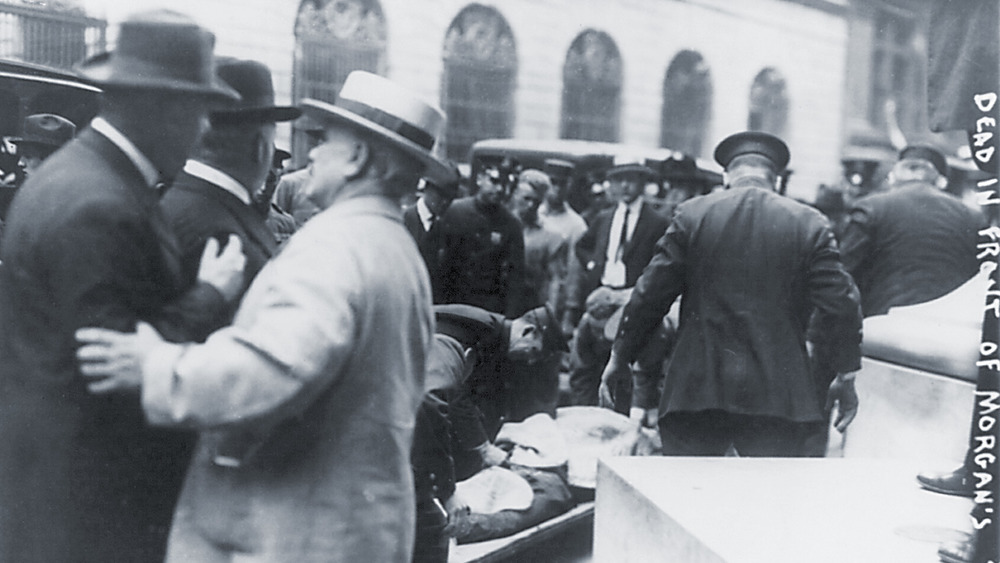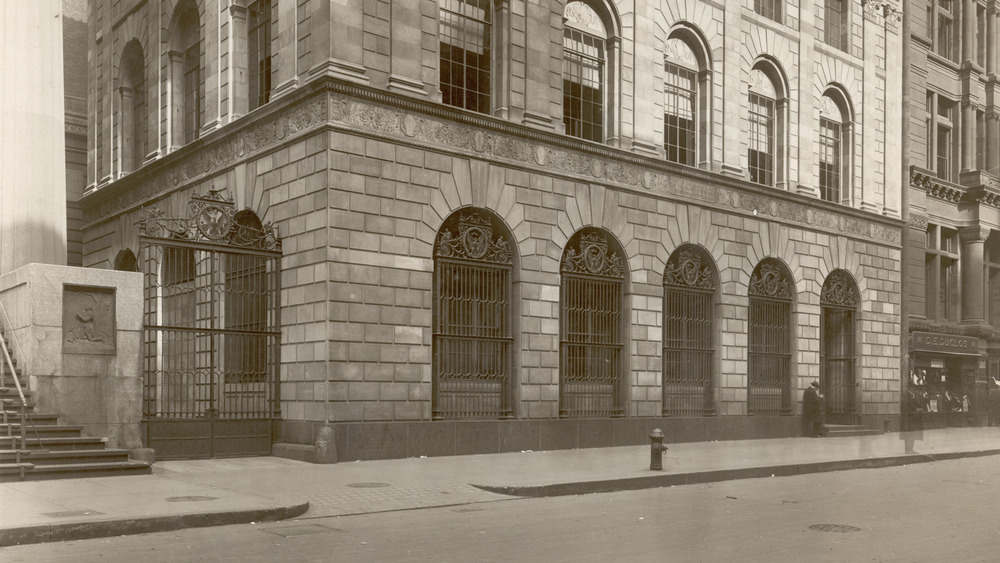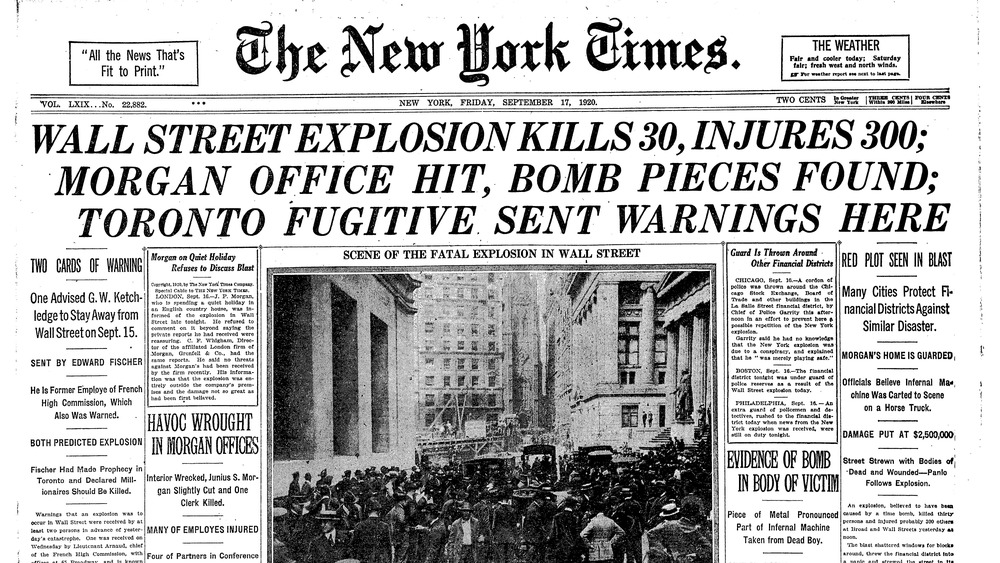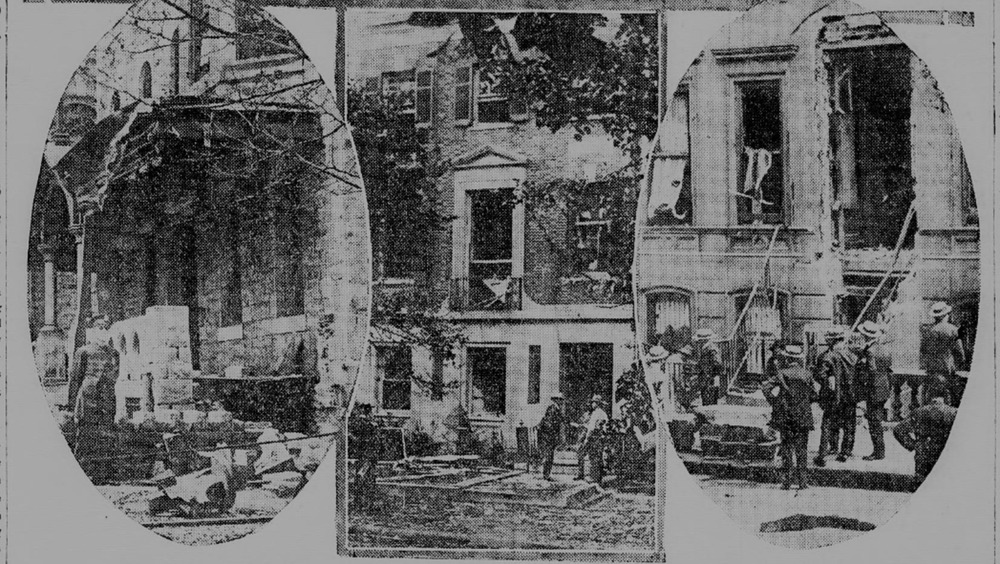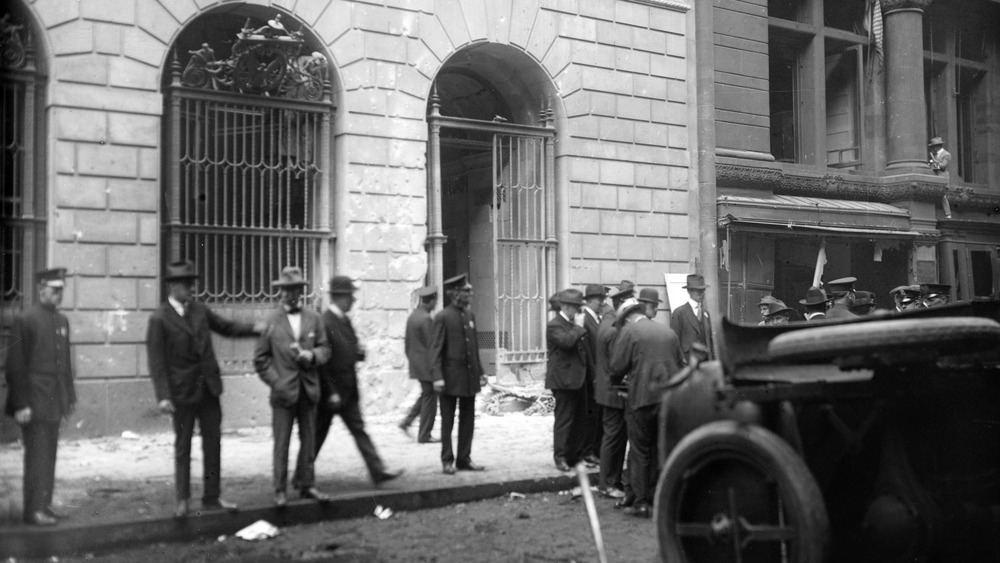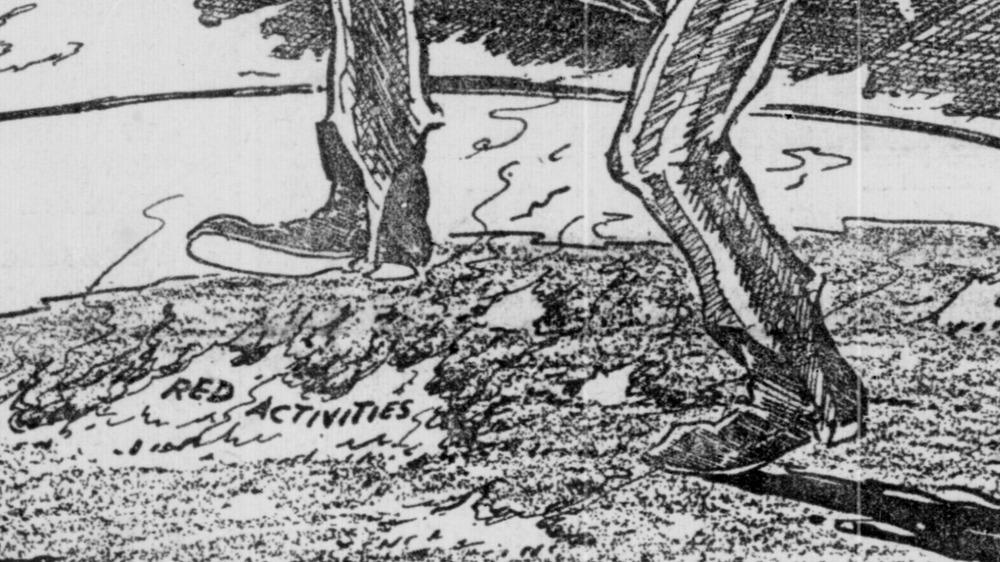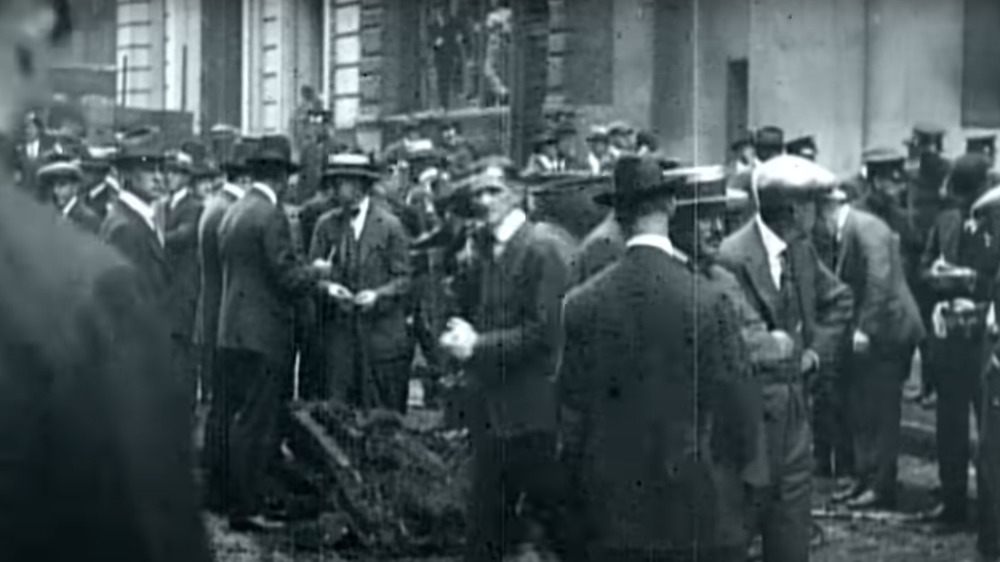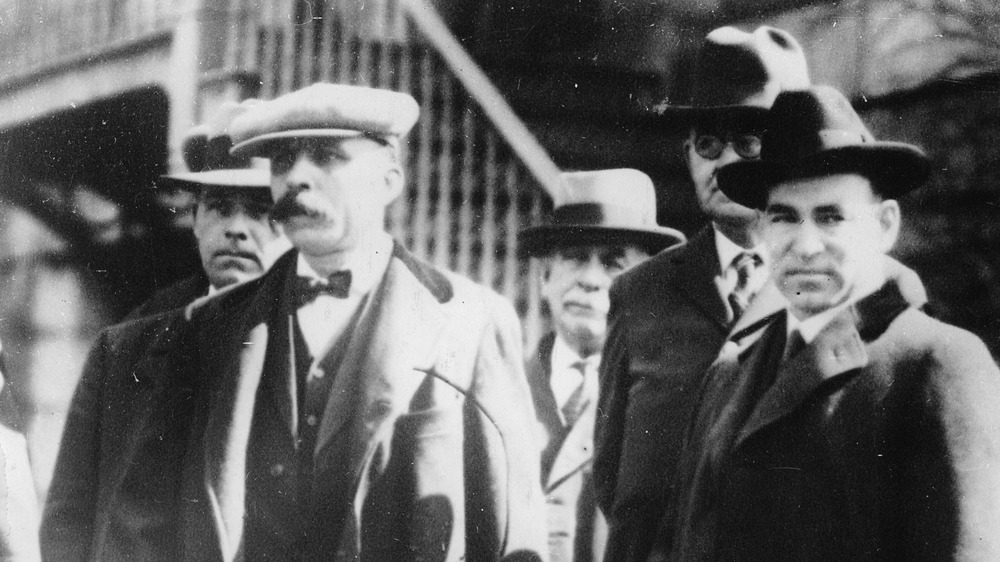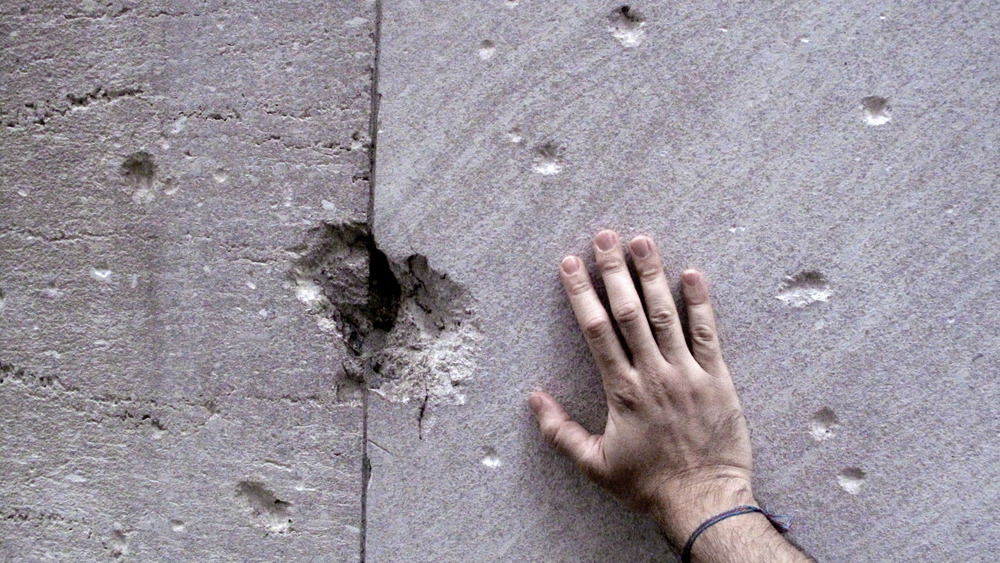The Story Behind The Wall Street Bombing Of 1920
Before September 11, 2001, the worst attack in New York City was the bombing of Wall Street in 1920. However, unlike September 11th, this bombing faded out of people's memory within five years. Other than the scarred limestone façade of 23 Wall Street, there's nothing to memorialize one of the most violent attacks in American history.
Despite the fact authorities later decided that Italian anarchists were responsible for the bombing, no one was ever charged or convicted for the attack, and both the FBI and the police gave up trying to solve the case in 1940. And although many believe that the attack was aimed at Wall Street businessmen and bankers, the victims ended up being messengers, clerks, vendors, and street workers.
The day after the bombing, the New York Stock Exchange was back in business as sheets were drawn over the previous day's devastation. In a single afternoon, Wall Street became a symbol of patriotism and America that the Reds were trying to tear down, and anyone who criticized the activities of Wall Street was suddenly eyed as a traitor. This is the story behind the Wall Street Bombing of 1920.
A brief history Wall Street
When the Dutch first colonized what would become New York, they created the wall that Wall Street would be named after. After the English conquered the territory in 1664, they maintained the wall for several years, although according to Curbed, the upkeep required was incredibly expensive. As a result, the wall was torn down in 1699.
According to The Street, Wall Street's existence as a financial center was based around slavery. "In 1711, New York named Wall Street the location of the city's slave market," a practice that continued for over a century. However, The Knickerbocker Vol. 34, notes that the slave-market may have existed as early as 1709, described as the "place [where] all negro and Indian slaves to be let out to hire, or to be sold, took their stand."
By the end of the 1700s, Philadelphia was also considered a financial center of the United States for "stock and commodity traders." Stockbrokers in New York decided that they wanted their own stock market to play with, as well as wanting "to keep out both government interference and any potential competitors." This resulted in the Buttonwood Agreement, where 24 stockbrokers in 1792 made a plan "to trade only with each other and for 0.25 percent commission." That same year, the Buttonwood stockbrokers had also created the New York Stock and Exchange Board, basing it off the one in Philadelphia. By 1918, Wall Street was considered more influential than the London Stock Exchange.
Midday on September 16th
One minute after noon on September 16, 1920, an abandoned wagon exploded outside of 23 Wall Street. According to New York Post, the wagon was parked right outside the headquarters of the J.P. Morgan & Company bank, and had been packed with at least 100 pounds of explosives. In Terrorism on American Soil, Joseph T. McCann writes that some witnesses claimed later to have seen a driver pull up with the wagon and then leave it unattended, but "conflicting descriptions" were given and didn't end up being very useful. And unfortunately, by this point, the damage had already been done.
Anyone near the blast was "no longer a complete person." According to The Street, "windows shattered throughout a half-mile radius," and cloth awnings in the area burst into flames. And two blocks away, a passenger trolley was "thrown from the tracks by the shock." The windows of the Stock Exchange building also shattered, but because of the large curtains many who were inside were able to avoid the flying glass. And since running isn't allowed on the trading floor, the president of the Stock Exchange had to walk briskly to the gong to stop the trading. This became "the first time trading had ever been halted by violence."
Outside the buildings, the street was cluttered with the remains of people, buildings, and cars, and as people fled the buildings they ended up "trampling over the bodies of the dead and injured," writes Damn Interesting.
Hundreds were injured in the Wall Street Bombing
39 people were killed and between 150 to 300 people were injured from the explosion. Crime Reads writes that many of those who were injured were "messengers crossing the street or clerks hit by shattered glass as they ate at their desks." Out of the 39 deaths, 30 people were killed instantly in the blast, per Slate. The horse tied to the wagon also died instantly. (The only pieces of the horse that were found were two charred hooves.) According to Terrorism on American Soil, three people were so badly mangled that their remains couldn't be identified.
Some of the injuries were due to the shrapnel — "an estimated 500 pounds of metal window-sash weights" had been packed with the explosive — while many more were struck by the shattered glass that fell from the broken windows. Hundreds of people lay in the street and "indescribably confusion followed the detonation."
According to Damn Interesting, the scene was pure carnage: "A woman's severed head, still wearing a hat, was stuck to the façade of the JP Morgan building." All that was found of Edward Sweet, a millionaire restaurateur, was one finger. Briefly, there was a wave of panic as a rumor spread that there was another bomb that was meant to go off nearby, but this turned out to be false. In an attempt to get away from the smoke and dust of the wreckage, crowds of people "staggered towards the Trinity Church." At least one person died by suicide five days after the explosion because of what they'd witnessed.
Security and soldiers arrive
Within half an hour of the explosion, Red Cross nurses and New York City policemen arrived at the site of the explosion. According to The Street, 75 nurses and almost 1,700 policemen arrived "by horse, car, subway, and foot." As roads were slowly cleared to make way for the ambulances, the sidewalks became lined with dead bodies.
Meanwhile, soldiers from the 22nd Infantry also arrived, "rifles and bayonets at the ready," to protect the US Assay office. Crime Reads writes that on that very day, "$900 million in gold bar was being moved out of the Sub-Treasury Building, which was next door to the new Assay Office, where the deadly wagon was parked." Because of this, there was a belief that the explosion was a botched robbery.
According to Hagley Museum, the explosion and subsequent shrapnel caused "$2 million in property damage to surrounding buildings." However, the financial damage had the potential to be even greater, since "a large percentage of the nation's gold reserves and paper wealth could have been incinerated in the explosion."
Who was responsible for the Wall Street Bombing?
City officials decided to reopen the New York Stock Exchange building the next day despite the fact that the perpetrators had yet to be caught. There was an increase of security, and according to The Street, Wall Street employees were "determined to show the world that business will proceed as usual despite bombs."
As a result, according to Crime Reads, "10 tons of broken glass were carted off to police headquarters" as evidence to be examined. Detectives also recovered the two remaining blackened horseshoes from the horse that was tied to the explosive wagon. Damn Interesting also writes that the NYPD collected pieces of "wagon wheel spokes, leather straps, chunks of canvas, an axle, and a hubcap from the original wagon." However, in the rush to make sure that the New York Stock Exchange could reopen, it's unclear how much useful evidence was swept up and disposed of.
Sometime before the explosion, leaflets had been discovered nearby that read "Remember/ We will not tolerate/ any longer/ Free the political/ prisoners or it will be/ sure death for all of you/ American Anarchist Fighters." Because of this, suspicions were immediately cast upon Italian-American anarchists and were thought to be bolstered by the fact that "a pair of Italian-American anarchists had been indicted five days earlier for bank robbery and murder."
Who were the Anarchist Fighters?
In 1919, the United States had been struck by another bombing campaign, during which they'd found handbills at the bombing sites signed the "The Anarchistic Fighters." Due to their similarity to the leaflets found after the 1920 Wall Street bombing, the Bureau of Investigations decided that the same organization was claiming responsibility.
However, the "American Anarchist Fighters" weren't exactly one cohesive group. According to Crime Reads, they were linked to a number of gangs, including the Galleanist anarchists. Led by Luigi Galleani, the Galleanists were thought to be responsible for the 1919 bombing campaign, and Galleani and eight others had already been deported in 1919. However, despite the fact that police didn't have enough evidence to arrest Galleani for the bombings, "they could deport him because he was a resident alien who had overtly encouraged the violent overthrow of the government." It also probably didn't help that he'd also authored a how-to book for making bombs.
And yet, despite the assurance with which the FBI now claims that the "American Anarchist Fighters" were responsible for the 1920 bombing, there has never been a single arrest made in connection with the bombing.
Reactions to the Wall Street Bombing
The media, the public, and the government reacted as though the country had gone to war. According to Damn Interesting, the Washington Post even described the bombing as an "act of war," and although no one knew for sure who the enemy was, many jumped to accuse either Russians and Bolsheviks or Italians and anarchists.
"No Wall Street businessmen were killed" as a result of the explosion, and people were uncertain as to whether or not J.P. Morgan had been a target of the explosion. However, Department of Justice agent Frank Francisco claimed, "If an attempt had been made on the Morgan offices, I believe it would have been made at night, or some radical would have secured a position in the institution and planted an infernal machine inside." But according to Crime Reads, William J. Flynn, chief of the Secret Service, said the bomb "was planted in the financial heart of America as a defiance of the American people. I'm convinced a nationwide dynamiting conspiracy exists to wreck the American government and society."
Before the bombing, many Americans had spoken out about "the unchecked growth of power underway on Wall Street." However, after the bombing, the public saw Wall Street as a symbol of patriotism, and anyone who spoke out against Wall Street was "denounced as supporters of violence and terror."
Not a single arrest
Although police and the Bureau of Investigations seemed convinced that Italian anarchists were responsible for the 1920 Wall Street bombing, they had very little to go on other than the leaflet that they found near the explosion. Many people were picked up and interrogated in the same vein as the Palmer Raids, but police kept coming up empty-handed. According to Untapped Cities, authorities still decided that "the bombing was a terrorism plot planned by anarchists and communist sympathizers who were staunchly anti-capitalist."
However, despite all of their investigations, not a single person was ever charged or convicted for the bombing. Damn Interesting writes that both the FBI and the NYPD "officially gave up on the case in 1940, having never identified any satisfactory suspects," but in 1944, they declared that Italian anarchists were responsible, pointing at the bombing campaign of 1919 as evidence.
According to the FBI, police tried to trace back the printing of the leaflets but they were unsuccessful. And although they were able to find the farrier who had shod the horse tied to the explosive wagon, the blacksmith's description of "a Sicilian man of 25-30 years old" didn't turn up any more leads.
The predictions of Edwin Fischer
One of the people that the authorities heavily investigated was Edwin Fischer, an American tennis champion. Damn Interesting reports that Fischer had apparently warned his friends that an attack was going to occur on Wall Street, and had even sent them "postcards enjoining them to leave the area before 16 September."
According to Medium, when police brought Fischer in for questioning, he was wearing a tennis outfit under his suit "to be ready for a tennis match at all times." And when asked how he knew of the attack, Fischer claimed that he received messages "through the air from God."
Police soon realized that this wasn't the first warning that Fischer had received and relayed. His friends admitted that Fischer frequently claimed that bombings were going to occur on Wall Street, and that although he was a "charming fellow," he was known to have periodic attacks of "irrational outbreaks." Authorities determined that Fischer wasn't connected to the bombing, and referred him to an asylum. There, he was committed and diagnosed as "insane but harmless."
Was the Wall Street Bombing revenge?
Some suggested that the Wall Street bombing was in response to the murder indictment of Nicola Sacco and Bartolomeo Vanzetti five days earlier in Dedham, Massachusetts. Mario Buda, an associate of Sacco and Vanzetti, was investigated, but he left the country some time after the bombing.
However, it's questionable whether or not the bombing was actually an act of revenge in such a manner. Considering that the Bureau of Investigations tied the bombing to Italian anarchists just because of a leaflet found nearby, it's likely that by connecting the bombing to the Sacco and Vanzetti trial, authorities were simply grasping at straws trying to find some motivation amongst Italian anarchists. Plus, when violence was carried out in response to the trial, its connection to the trial was obvious. For example, according to UMKC, in 1932, the judge who presided over the case had his house bombed due to his role in the Sacco and Vanzetti trial. In this instance, it makes more sense to ascribe the bombing to the Sacco and Vanzetti trial.
However, neither the Bureau of Investigations nor the police were able to come up with any sort of motive for the bombing. Some maintained that J.P. Morgan was the target, but at the time he was in Scotland. At the end of the day, all that anyone gathered from the event was that "the Wall Street bombing struck at the powerful and killed the ordinary," writes Crime Reads.
Legacy of the Wall Street Bombing
Surprisingly, websites like The Street don't mention the 1920 bombing of Wall Street in their timeline of Wall Street. And according to Damn Interesting, on the actual street there's nothing to mark "the site of one of the deadliest terror attacks in US history." There isn't even a little sign. However, this isn't to say that the location has no physical reminder of the explosion. Slate reports that "the limestone façade of 23 Wall Street still bears the scars from the shrapnel that blasted into it 94 years ago. These little marks are the only on-site hint of the attack." And it seems that these marks will remain, since J.P. Morgan said on the record "they'll never repair the damage."
However, The New York Times describes the incident as "The Opposite of 'Never Forget.'" Apparently, this quick dismissal was purposeful. "The Morgan bank from the first was rather self-conscious about wanting to get the whole thing over with and forgotten because it wasn't terribly good for business."
For the 100th year anniversary, the city had made no plans to commemorate the bombing, but Brian Andersson, the city's former Archives Commissioner, decided to organize a memorial event. According to History News Network, Andersson stated, "I've known this fact about my hometown my whole life and decided that it should be commemorated properly. As there were no plans by anyone to do something, I've taken it upon myself."
